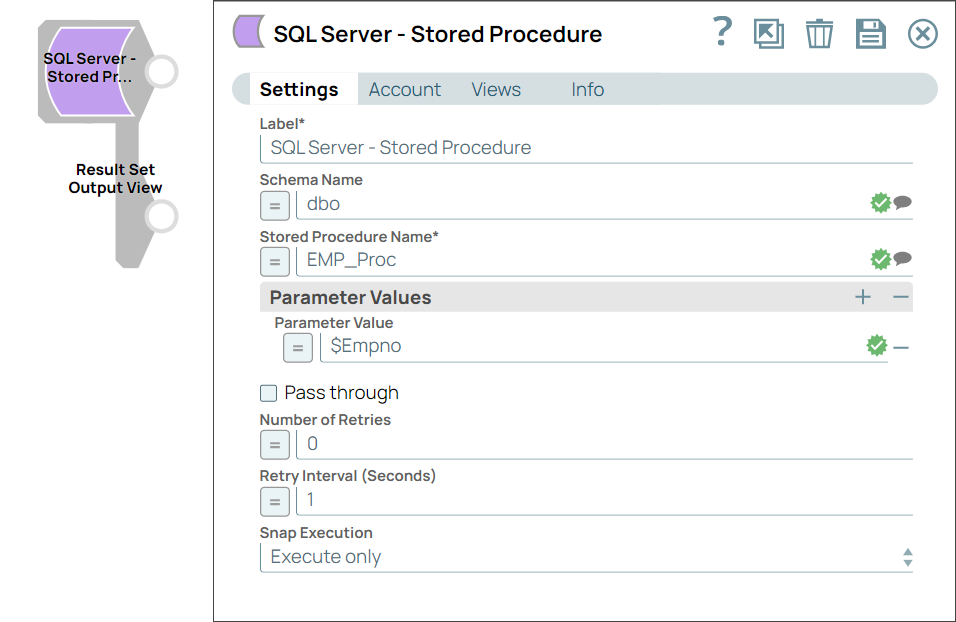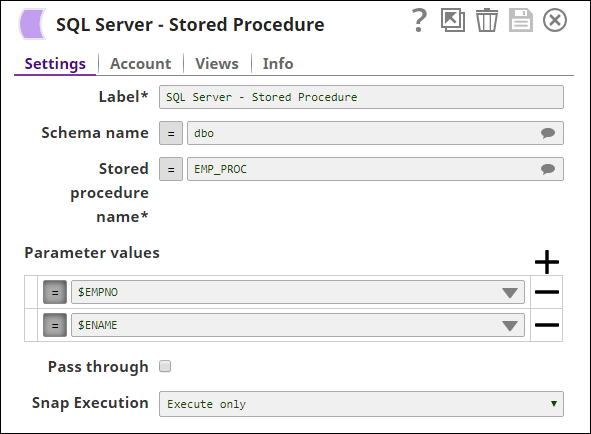In this article

Overview
You can use this Snap to execute a stored procedure in a SQL Server database and writes the values of OUT parameters to the output view.
Starting from SQL Server 2008, the result set from a Transact-SQL statement or stored procedure includes the count of the number of rows affected. This Snap fails to parse this extra information and may display an error (such as Failed to process result set). To fix the issue, add the following line to the stored procedure to turn off the output of the count: SET NOCOUNT ON |

Snap Type
SQL Server - Stored Procedure is a Write-type Snap that executes an SQL Server stored procedure.
Prerequisites
None.
Support for Ultra Pipelines
Works in Ultra pipelines.
Limitations & Known Issues
None.
Snap Views
Type | Format | Number of Views | Examples of Upstream and Downstream Snaps | Description |
|---|
Input | Document | | | This Snap allows up to one input view. If an input view is defined, then values from an incoming document can be used as input parameters to the stored procedure. |
Output | Document | | | This Snap has exactly two document output views, one regular output view, and one Result Set output view. |
Error | Error handling is a generic way to handle errors without losing data or failing the Snap execution. You can handle the errors that the Snap might encounter when running the Pipeline by choosing one of the following options from the When errors occur list under the Views tab: Stop Pipeline Execution: Stops the current pipeline execution if the Snap encounters an error. Discard Error Data and Continue: Ignores the error, discards that record, and continues with the remaining records. Route Error Data to Error View: Routes the error data to an error view without stopping the Snap execution.
Learn more about Error handling in Pipelines. |
Snap Settings
Asterisk (*): Indicates a mandatory field. Suggestion icon ( ): Indicates a list that is dynamically populated based on the configuration. ): Indicates a list that is dynamically populated based on the configuration. Expression icon ( ): Indicates whether the value is an expression (if enabled) or a static value (if disabled). Learn more about Using Expressions in SnapLogic. ): Indicates whether the value is an expression (if enabled) or a static value (if disabled). Learn more about Using Expressions in SnapLogic. Add icon ( ): Indicates that you can add fields in the field set. ): Indicates that you can add fields in the field set. Remove icon ( ): Indicates that you can remove fields from the fieldset. ): Indicates that you can remove fields from the fieldset.
|
Field Name | Field Type | Description |
|---|
Label* Default Value: SQL Server - Stored Procedure
Example: SQL Server - Stored Procedure | String | Specify the name for the Snap. You can modify this to be more specific, especially if you have more than one of the same Snap in your Pipeline. |
|---|
Schema Name Default Value: N/A
Example: schema_demo | String/Expression | Specify the schema name where the procedure resides. The property is suggestible and will return all schemas of the DB. noteThe values can be passed using the pipeline parameters but not the upstream parameter.
The values can be passed using the pipeline parameters but not the upstream parameter.
|
|---|
Stored Procedure Name* Default Value: N/A
Example: addSeventeen | String/Expression | Specify the Stored Procedure to execute. The property is suggestible and will return all procedures of the DB. If a package is defined, then it will only return the procedures of that package. If a schema is defined and no package is defined, then it will return all procedures of that schema. |
|---|
Parameter Values | Use this fieldset to set Parameter Values to be used in the stored procedure. The parameter values will be bound to input columns in the order they appear in the list. |
|---|
Parameter Value Default Value: N/A
Example: Suppose there is a stored procedure named createGreeting. It has three parameters p1,p2, and p3. p1 and p2 are input parameters of type VARCHAR2. Then there have to be two string values provided. The first value goes to p1 and the second to p2. | String/Expression | Specify the input parameter values for the stored procedure. If you define parameter values, you must do so in the same order as they appear in the stored procedure definition. noteQuotation marks should not be used when setting input parameters unless they are part of the input value itself, since they are treated as escaped plain characters. For example, if the desired input value is TEST_VALUE1, the input parameter should be set as TEST_VALUE1, if you set it as "TEST_VALUE1", it will be recognized as \"TEST_VALUE1\". If you do not provide any parameters in the Snap, you can still view the required input parameters in the Target Schema of the upstream Mapper Snap. The parameters are dynamically populated based on the column keys of the stored procedure; you can map the parameters and pass them as an input to the Stored Procedure Snap
Quotation marks should not be used when setting input parameters unless they are part of the input value itself, since they are treated as escaped plain characters. For example, if the desired input value is TEST_VALUE1, the input parameter should be set as TEST_VALUE1, if you set it as "TEST_VALUE1", it will be recognized as \"TEST_VALUE1\". If you do not provide any parameters in the Snap, you can still view the required input parameters in the Target Schema of the upstream Mapper Snap. The parameters are dynamically populated based on the column keys of the stored procedure; you can map the parameters and pass them as an input to the Stored Procedure Snap
Bypassing ParametersIf you wish to bypass any parameter then add a blank row in its place in this section. This is required since the Snap expects the parameters in the order in which they are defined. For example, if there are three parameters and they are defined as Pipeline parameters _empid, _empname, and _loc and you wish to by pass the parameter _empname, then the Snap should be configured as: 
|
|
|---|
Pass through
Default Value: Deselected | Checkbox | If selected, the input document will be passed through to the output views under the key 'original'. The document will be passed to the Parameter output view, and it will also be passed to the Result Set output view if there is output sent from this view. noteThis property applies only to the Execute Snaps with SELECT statement or the Select Snaps.
This property applies only to the Execute Snaps with SELECT statement or the Select Snaps.
|
|---|
Number of retries Default Value: 0
Example: 3 | Integer/Expression | Specify the maximum number of attempts to be made to receive a response. The request is terminated if the attempts do not result in a response. |
|---|
Retry interval (seconds) Default Value: 1
Example: 10 | Integer/Expression | Specify the time interval between two successive retry requests. A retry happens only when the previous attempt resulted in an exception. |
|---|

Default Value: Execute only
Example: Validate & Execute | Dropdown list | 
|
|---|
The Snap does not support the custom type parameter since SQL Server JDBC driver lacks support for this feature. http://blogs.msdn.com/b/jdbcteam/archive/2012/04/03/how-would-you-use-table-valued-parameters-tvp.aspx |
Examples
The following example is an application of the SQL Server Stored Procedure Snap for the example found at http://database.ittoolbox.com/groups/technical-functional/sql-server-l/example-of-code-that-overloads-a-sql-server-stored-procedure-5406272
Create a table called dbo.EMP by executing the following code:
CREATE TABLE [dbo].[EMP]( [EMPNO] [int] NOT NULL, [ENAME] [varchar](10) COLLATE SQL_Latin1_General_CP1_CI_AS NULL, [DEPTNO] [int] NOT NULL, CONSTRAINT [EMP_EMPNO_PK] PRIMARY KEY CLUSTERED ( [EMPNO] ASC )WITH (IGNORE_DUP_KEY = OFF) ON [PRIMARY] ) ON [PRIMARY] |
Insert several rows:
INSERT INTO [dbo].[EMP] VALUES (1111,’EDWARDS’,10);
INSERT INTO [dbo].[EMP] VALUES (2222,’ALLEN’,10);
INSERT INTO [dbo].[EMP] VALUES (3333,’WATTS’,20);
INSERT INTO [dbo].[EMP] VALUES (4444,’KIRAN’,20);
INSERT INTO [dbo].[EMP] VALUES (5555,’CASTER’,20);
INSERT INTO [dbo].[EMP] VALUES (6666,’VIJI’,30);
INSERT INTO [dbo].[EMP] VALUES (7777,’DATTA’,30); |
Create a store procedure "EMP_PROC" with three input parameters:
CREATE proc [dbo].[EMP_PROC] @empno int=null, @ename varchar(10)=null, @deptno int=null AS IF EXISTS(SELECT 1 from [EMP] where EMPNO = @empno) BEGIN UPDATE [EMP] SET [EMPNO] = COALESCE(@empno,EMPNO), [ENAME] = COALESCE(@ename,ENAME), [DEPTNO] = COALESCE(@deptno,DEPTNO) WHERE EMPNO = @empno END |
Build and execute the pipeline:

The input data to the SQL Server - Stored Procedure Snap is:
{
"EMPNO" : 1111,
"ENAME" : "Ted",
"DEPTNO" : 20 } |
Only two input parameter values are provided while there are three input parameters in the procedure. This is possible because the procedure is written to support the overload feature. Executing the above pipeline will result in the update of ENAME value in the first row from "EDWARD" to "Ted". |
Downloads


Snap Pack History
Related Content
 ): Indicates a list that is dynamically populated based on the configuration.
): Indicates a list that is dynamically populated based on the configuration. ): Indicates whether the value is an expression (if enabled) or a static value (if disabled). Learn more about Using Expressions in SnapLogic.
): Indicates whether the value is an expression (if enabled) or a static value (if disabled). Learn more about Using Expressions in SnapLogic. ): Indicates that you can add fields in the field set.
): Indicates that you can add fields in the field set. ): Indicates that you can remove fields from the fieldset.
): Indicates that you can remove fields from the fieldset.


